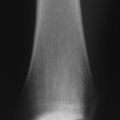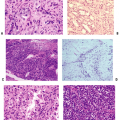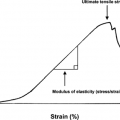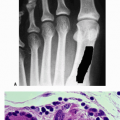Biomaterials
Joseph A. Spadaro
Michael T. Clarke
Julie M. Hasenwinkel
The advances made in contemporary orthopaedic surgery are intimately related to the development of and use of implant biomaterials. These are materials used to augment, repair, or replace natural tissues or assist in healing. Currently, biological performance is as influential as the mechanical properties of its component materials in the design of an implant. It is now recognized that no implanted biomaterials are actually inert. In fact, instead of demanding inertness, most surgical specialties are embracing “bioactivity” as a means toward a fuller regeneration of the normal state. Orthopaedics is no exception. Only by the orchestration of the mechanical, chemical, and biological behaviors of these biomaterials can further improvements be made.
An understanding of the general principles is therefore crucial to implant selection and expectations on behavior.
Metals and Metallic Alloys
Metals and their alloys of other metallic and nonmetallic elements are used as implants in orthopaedic surgery mainly for bearing and structural components that are typically affixed to bone.
Benefits: bulk biocompatibility, strength, resistance to fatigue failure over millions of cycles
Drawbacks: susceptibility to corrosion, potential for immune stimulation, particulate cytotoxicity and mutagenicity, possibility of fatigue failure in the long term
Implant Manufacture
Raw material is processed in one of three ways (frequently, a combination of two or three is necessary for final implant shape; Table 17-1 gives definitions).
Machining: includes lathing, milling, or grinding of material
Casting: molten alloy is poured into a mold (subsequently broken)
Forging: by bending, compressing, and impacting (often at elevated temperatures)
Final modifications of an implant frequently used are:
Coating (to enhance bone ingrowth or ongrowth)
Plasma spray of powdered hydroxyapatite or metal alloy
Cold deposition of hydroxyapatite
Sintering of beads or wire
Grit blasting (to enhance frictional interference with cement or bone)
Polishing (to enhance appearance, reduce corrosion, and reduce friction on cement)
Shot peening (to enhance fatigue properties of critical areas [e.g., Morse taper junctions])
Alloys in Current Use
Although new alloys are constantly being developed, there are four broad classifications of alloy types currently in common orthopaedic use:
Table 17-1 Some Metallurgical Definitions
Term
Definition
Cold working
The alteration of the shape or size of a metal by plastic deformation. Processes include rolling, drawing, pressing, spinning, extruding, and heading; are carried out below the recrystallization point, usually at room temperature. Hardness and tensile strength are increased with the degree of cold work, while ductility and impact values are lowered.
Hot working
The rolling, forging or extruding of a metal at a temperature above its recrystallization point without significant strain hardening
Warm working
Processing in a range usually 0.3 to 0.6 of melting point
Forging
A process of working metal to a finished shape by hammering or pressing; primarily a “hot” operation. It is applied to the production of shapes either impossible or too costly to make by other methods or needing properties not obtainable by casting. Categories of forgings include hammer, press, drop, or stamping.
Wrought
An alloy that has been significantly “worked” to break down its cast structure
Solution heat treatment
A process in which an alloy or metal is heated to a suitable temperature, is held at that temperature long enough to allow a certain constituent to enter into solid solution, and is then cooled rapidly to hold that constituent in solution. Most solution heat treatments soften or anneal.
Annealing
A heat treatment that relieves internal stress. Solution-annealed material is frequently in its most corrosion-resistant and ductile condition.
Work hardening
A term that signifies crystalline changes when a material is strained beyond its yield point
Grain boundary
As metals solidify (crystallize), many individual regions (grains) form with differing orientations of the atomic lattice. The region where grains meet (boundary) is less dense and more chemically reactive than the bulk material.
Passivation
A process of formation of an oxide layer on the surface of an alloy or metal. This can be spontaneous in the environment or enhanced chemically, for example by immersion in nitric acid. Passivation generally leads to improved corrosion resistance.
Titanium alloys
Cobalt chromium alloys
Stainless steel alloys
Tantalum-carbon
Titanium and its Alloys
Although developed as an aerospace alloy, titanium is well known in the medical field for its biocompatibility and high strength-to-weight ratio.
It is broadly used in the manufacture of fracture and spinal fixation devices as well as nonarticulating joint replacement components.
Orthopaedic Uses of Titanium Alloy
Fracture and spinal fixation devices: screws, plates, in-tramedullary nails
Joint replacement components
Cementless total hip: acetabular shells, femoral stems, ingrowth or ongrowth coatings
Not femoral heads (historically abandoned due to high wear)
Total knee: tibial tray, ingrowth or ongrowth coatings
Not femoral bearing surfaces (historically abandoned due to high wear)
Metallurgy
Titanium is typically alloyed with other elements as well as being thermomechanically treated to achieve the desired properties for implantation.
Metallic alloying increases the strength and maintains ductility by replacing titanium atoms in the crystal lattice with other metal atoms such as aluminum, vanadium, zirconium, and niobium.
Nonmetallic interstitial elements such as oxygen, carbon, and nitrogen lie in voids between atoms of titanium.
Strength is gained, but ductility and toughness are reduced.
The natural crystal state for pure titanium (CPTi) is an alpha phase with a hexagonal close packed (hcp) crystal lattice.
An alternate beta, body centered cubic (bcc) crystal phase is present in varying extents in titanium alloys depending on the alloy and heat treatments performed.
Beta-phase alloys can be harder and more brittle than alpha-phase ones.
In the commonly used titanium—aluminum—vanadium, an alpha-beta alloy, aluminum stabilizes the alpha phase and vanadium the beta phase.
The newer substantially beta-phase alloys containing molybdenum impart superior strength to an alloy and have the lowest elastic modulus (80 MPa) of any of the commonly used bulk implant alloys (e.g., CoCrMo 200 MPa).
Box 17-1 General Advantages and Disadvantages of Titanium Alloys
Advantages
Excellent biocompatibility
Relatively low elastic modulus
Spot welding to itself in taper junctions
Low galvanic corrosion to CoCrMo alloy
Disadvantages
Poor wear properties Notch sensitive
Concern with vanadium and aluminum content in specific alloys
Titanium Implant Characteristics (Box 17-1 and Table 17-2)
Advantages
Biocompatibility: result of a highly inert, insoluble, and adherent 10-nm-thick surface passivation layer of titanium oxide (titania, TiO2), allowing superior corrosion resistance
Inert passivation layer of TiO2 significantly reduces galvanic corrosion to cobalt base alloys at taper junctions (e.g., femoral head/femoral stem of total hip replacement [THR]).
Low elastic modulus (80 to 110 Mpa)
Useful in the prevention of stress shielding around cementless implants such as femoral hip replacement stems, but is to be avoided when used with polymethylmethacrylate (PMMA) cement as it is prone to increased cement stresses from bending as well as abrasive wear against cement due to poor wear properties
Spot welding at titanium-titanium taper junctions (e.g., stems on tibial base-plate for total knee replacement [TKR]) minimizes micromotion and fretting.
Disadvantages
Poor wear properties: resulted in general abandonment of titanium alloys as wear surfaces except for custom implants (e.g., in nickel-sensitive patients where cobalt alloy or stainless steel are to be avoided)
For custom titanium bearing surfaces, surface hardening is performed (e.g., ion implantation or nitriding)
Even the nitrided surface may be subject to delamination.
Notch sensitivity: problem for all alloys, but particularly so for titanium
Sharp angles, scratches, and sintered powder or beads allow stress risers to concentrate in one area, significantly reducing the fatigue life of an implant.
Vanadium, and to a lesser extent aluminum, are considered undesirable elements due to cell cytotoxicity seen in vitro and theoretical concerns about biocompatibility. Newer, currently unproven alloys that omit one or both of these alloys have been developed to avoid these theoretical concerns.
Cobalt-Based Alloys
Cobalt-based alloys, most notably of the cobalt-chromium binary system, are widely used for load bearing as a result of their fatigue resistance, and for wear surfaces as a result of their exceptional hardness when properly formed. Many of the properties of the alloys arise from the following:
Table 17-2 Different Uses of Some Titanium Alloys | ||||||||||||||||||||
|---|---|---|---|---|---|---|---|---|---|---|---|---|---|---|---|---|---|---|---|---|
| ||||||||||||||||||||
Box 17-2 General Advantages And Disadvantages of Cobalt-Based Alloys
Advantages
Good biocompatibility Fatigue-resistant Wear-resistant
Low galvanic corrosion to titanium
Disadvantages
Galvanic corrosion to stainless steel
Concerns regarding nickel content
Cobalt and chromium ion release
High elastic modulus
Expensive
Difficult to process
Crystal structure of cobalt
Strengthening effects of chromium, nickel, tungsten, and molybdenum
Formation of hard metal carbides (e.g., chromium carbide)
Corrosion resistance imparted by chromium, nickel, and molybdenum alloying elements
Orthopaedic Uses of Cobalt Alloys
Fracture and spinal fixation devices: braided wire for fracture fixation
Joint replacement components
Femoral heads for metal-on-plastic and metal-on-metal bearings
Femoral stems for cemented and cementless THR
Femoral component for TKR
Ingrowth or ongrowth coatings on implants (e.g., THR/TKR)
Metallurgy
Cobalt alloy in cast or wrought forms is typically alloyed with varying amounts of chromium and molybdenum.
Tungsten and nickel are used in some alloys to achieve the desirable properties of strength, fatigue resistance, and corrosion resistance.
Mechanical properties of cast alloys can be improved by hot forging that removes pores and reduces grain size.
In some alloys (e.g., MP35N), cold working can change the crystal structure from a face centered cubic (fcc) lattice to an hcp one, creating a biphasic alloy that has improved resistance to plastic deformation and increased strength.
The presence of carbon is carefully controlled as this can affect the mechanical properties, including toughness, wear resistance, and corrodibility.
High carbon (>0.14% w/w) alloy is used as bearing surfaces against itself.
Low carbon (<0.14% w/w) alloy is used as structural members as well as for coating applications in addition to bearing applications against the ultra-high-molecular-weight form of poly(ethylene) (UH-MWPE).
Cast alloy may be porous, and mechanical properties are improved by hot forging or hot isostatic pressing (HIP) that removes pores and reduces grain size.
HIP is a process of heat treatment in argon gas at high temperature (e.g., 1200°C) and pressure (e.g., 1000 Atmospheres), followed typically by solution annealing.
Advantages
Biocompatibility
Provided by a chromium oxide passivation layer that may be enhanced prior to implantation by cleaning, polishing, and an oxidizing nitric acid bath (see Table 17-1)
The solubility in water, however, is greater than TiO2 and there is susceptibility to crevice corrosion, with concern about possible loss of implant fixation in the long term when directly apposed to bone.
Improved fatigue resistance
THR stem fractures with cast stems: a concern in the past
Better metallurgical processing of alloys and improved alloy compositions have essentially eliminated this as a problem, to the point where wrought cobalt alloys provide some of the most fatigue-resistant alloys available for implantation.
Wear resistance
Table 17-3 Different Uses of Some Cobalt Alloys
Material
Crystal Structure
Uses
Notes
Cast cobalt-chromium-molybdenum alloy (ASTM F75)
fcc
Femoral heads, metal-on-metal bearings, femoral component of TKR
Comes in high- or low-carbon versions. Can be heat treated (hipped, solution annealed). Low nickel content.
Wrought cobalt-chromium-molybdenum alloy (F799, F1537)
fcc
Cemented femoral stems, metal-on-metal bearings
Wrought version of cast F75. Comes in high- and low-carbon versions. Low nickel content.
Wrought cobalt-chromium-nickel-molybdenum
fcc and hep
Femoral stems
Extremely strong; fatigue and corrosion resistant. High nickel content has caused limited use in vivo.
Table 17-4 Mechanical Properties of Some Implant Alloys
Alloy
Yield Strength (Mpa)
Ultimate Tensile Strength (MPa)
Fatigue Strength (Mpa)
Elastic Modulus (Mpa)
Titanium Alloys
Alpha-phase commercially pure titanium
Grade 1 (0.18% oxygen)
172
241
—
110
CpTi (ASTM F67 by ATI Allvac)
Grade 4 (0.4% oxygen)
480
550
380
110
Alpha-beta-phase titanium-aluminum-vanadium (ASTM F136 by ATI Allvac)
793
862
600
110
Beta-phase titanium-molybdenum-zirconium-iron alloy (ASTM F1813 by ATI Allvac)
965
1000
—
80
Cobalt Alloys
Cast cobalt-chromium-molybdenum alloy (ASTM F75)
As cast
450-520
655-890
207-310
210
HIPped
841
1277
725-950
253
Wrought cobalt-chromium-nickel alloy (ASTM F562 by Carpenter-MP35N)
Annealed
414
931
—
232
55% cold-worked
1413
1827
—
232
53% cold-worked and aged
1999
2068
793 max
232
Wrought cobalt-chromium-molybdenum alloy (ASTM F799/F1537 by Carpenter-BioDur CCM plus)
Annealed
882
1351
—
—
Hot-worked
930
1365
900 max
210
Stainless Steels
Nitrogen-strengthened stainless steel (ASTM F1586 by Sandvik-Bioline Hign N)
Annealed
430
740
—
—
Cold-worked
1100
1350
—
—
AISI 316L stainless steel (ASTM F138 by Sandvik-Bioline 316LVM)
Annealed
190
490
270
200
Cold-worked
800
1100
300
200
Nickel-free stainless steel (ASTM F2229 by Carpenter-Biodur 108)
Annealed bar and wire
607
931
381
40% cold-worked bar and wire
1551
1731
80% cold-worked (wire only)
1862
2206
Forged material water quenched for hip implants
1036
1253
513
Tantalum
Pure Ta (ASTM 560-04)
Solid material
345
186
Ta-C
75% porous components
63
3
The numbers shown are frequently greater than the ASTM minimum specifications. 
Stay updated, free articles. Join our Telegram channel

Full access? Get Clinical Tree







